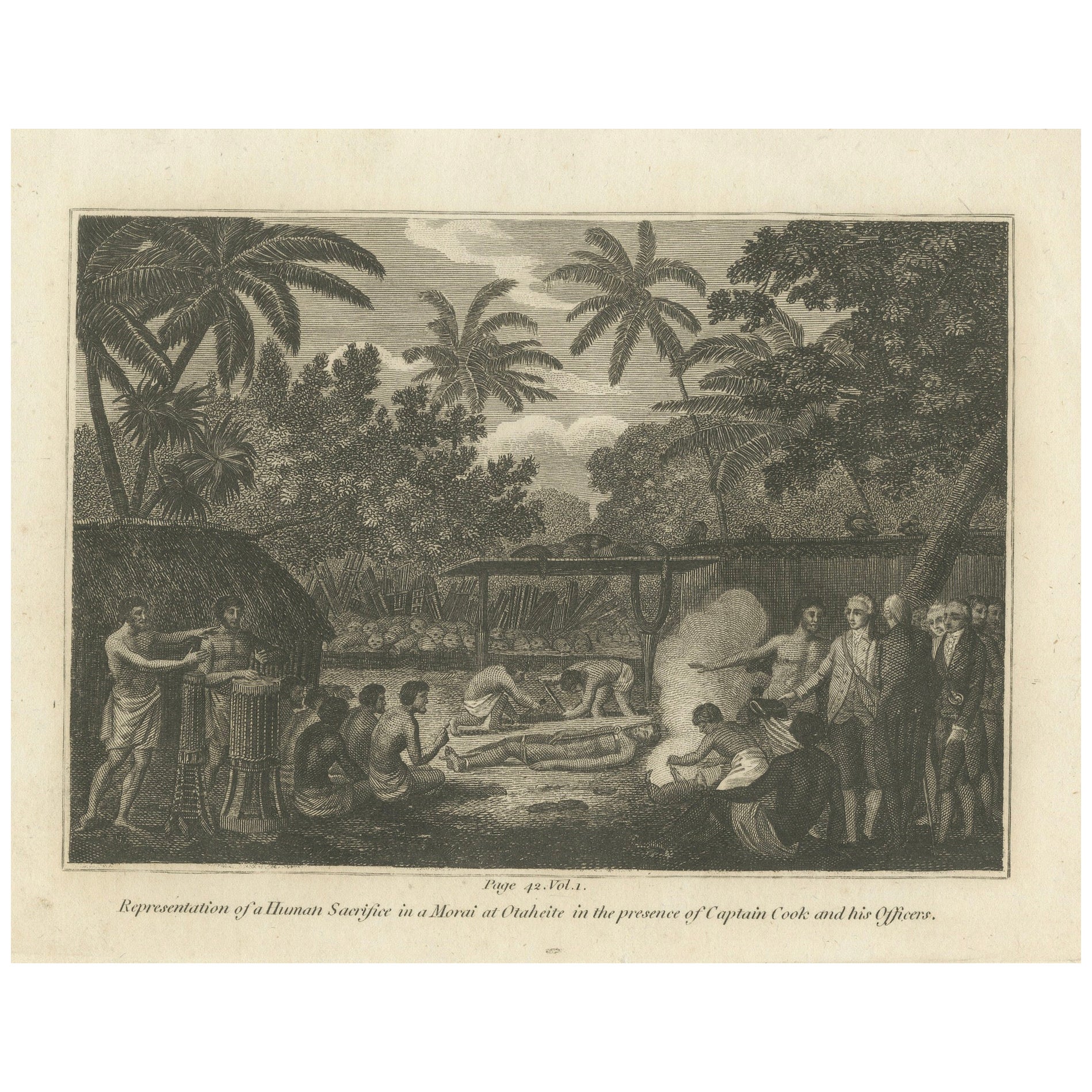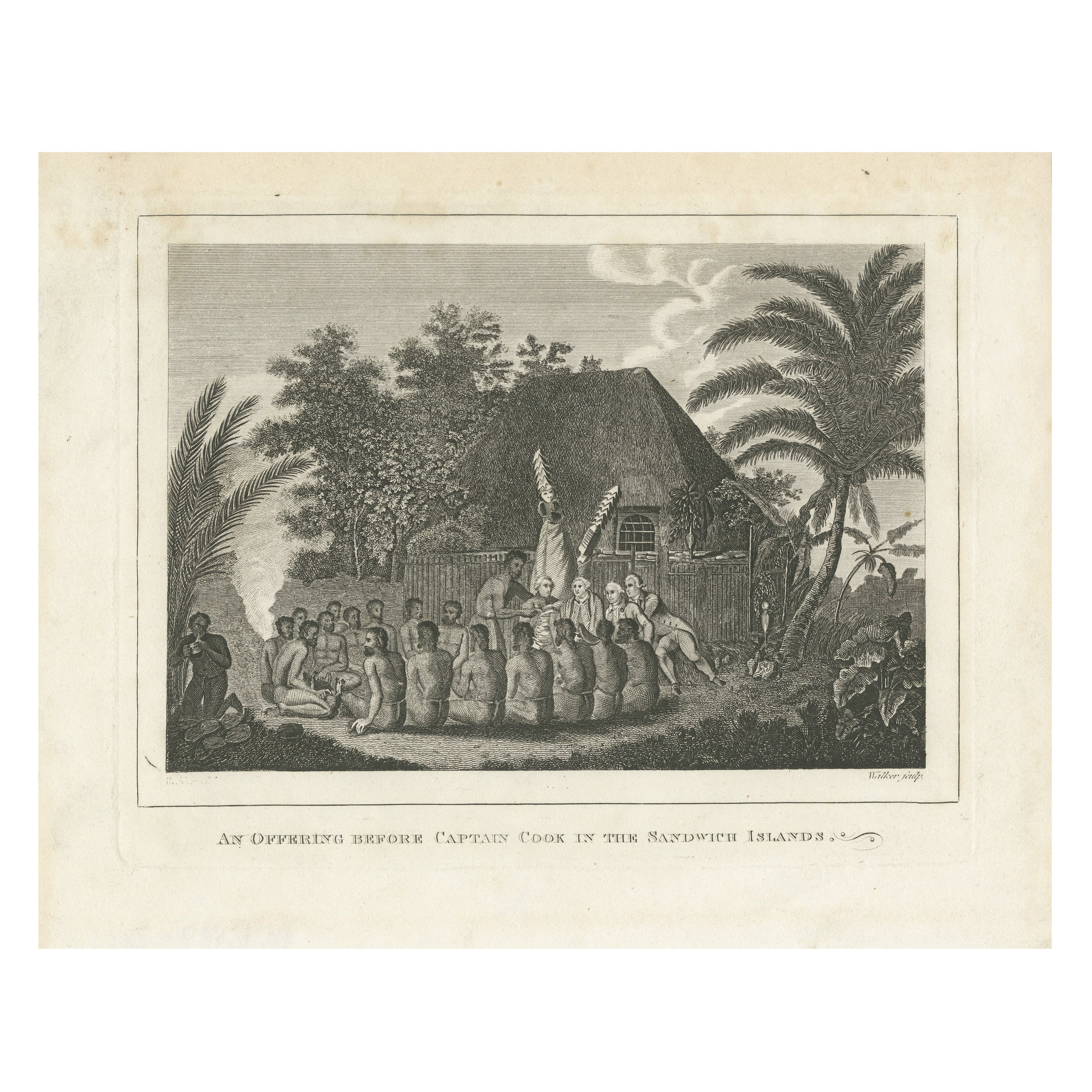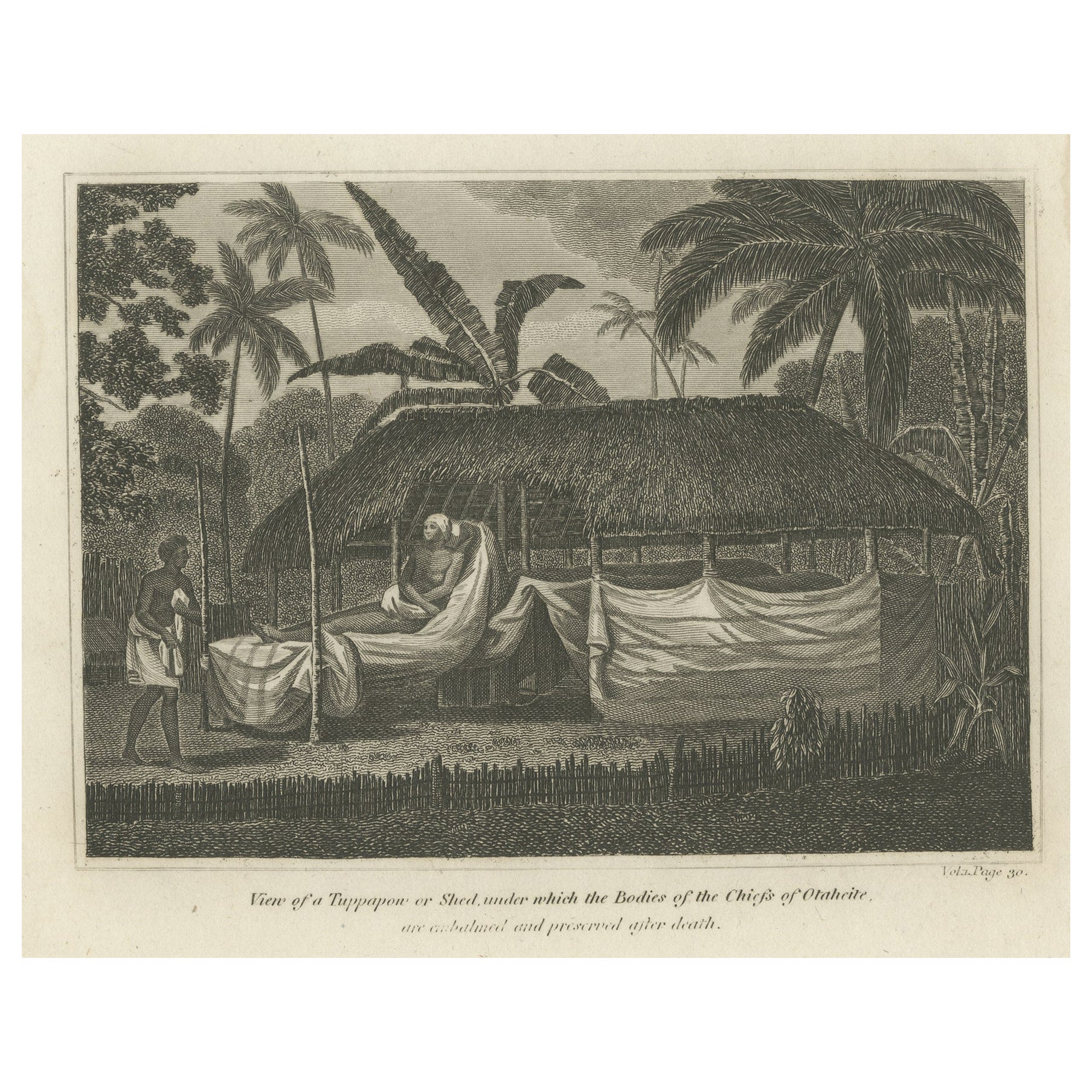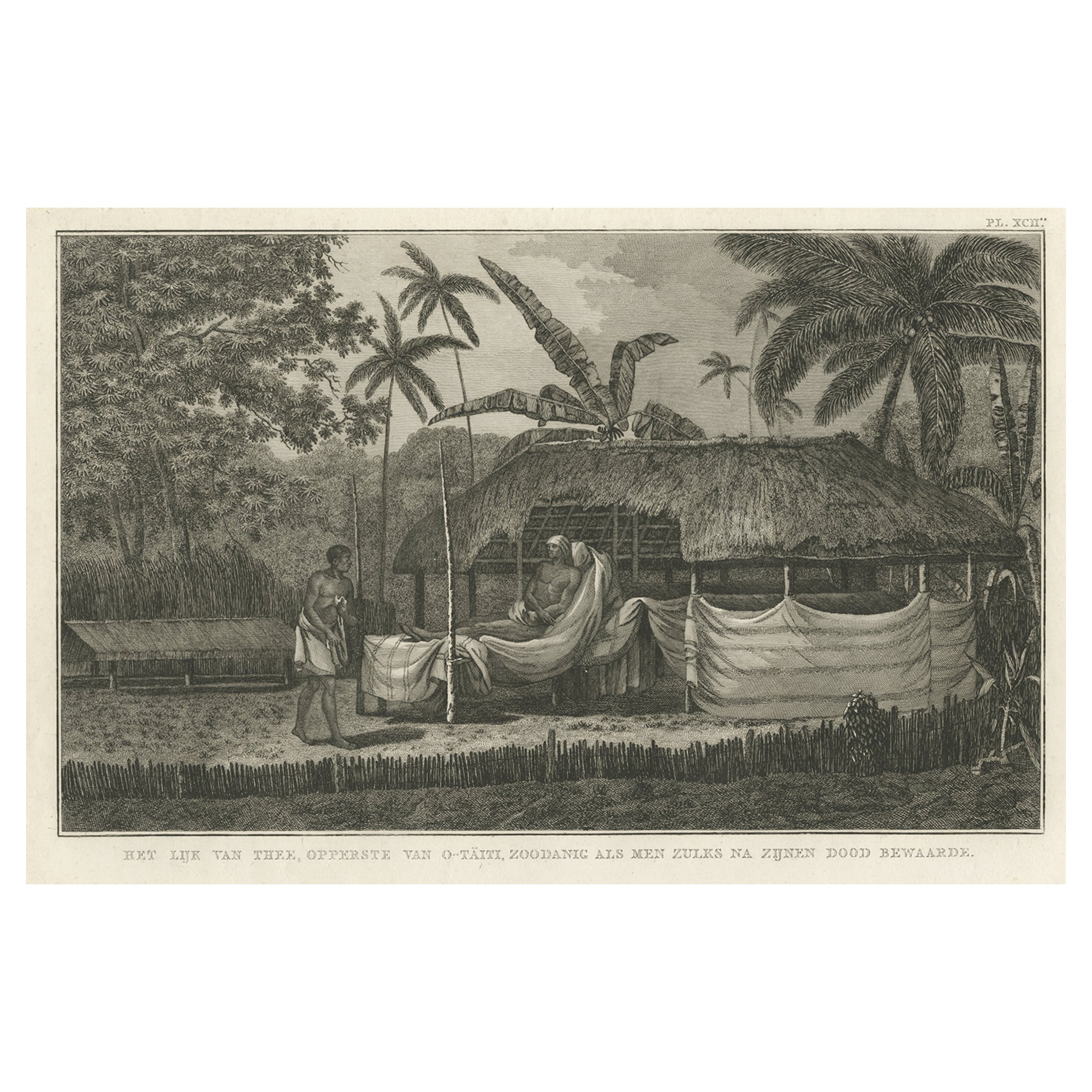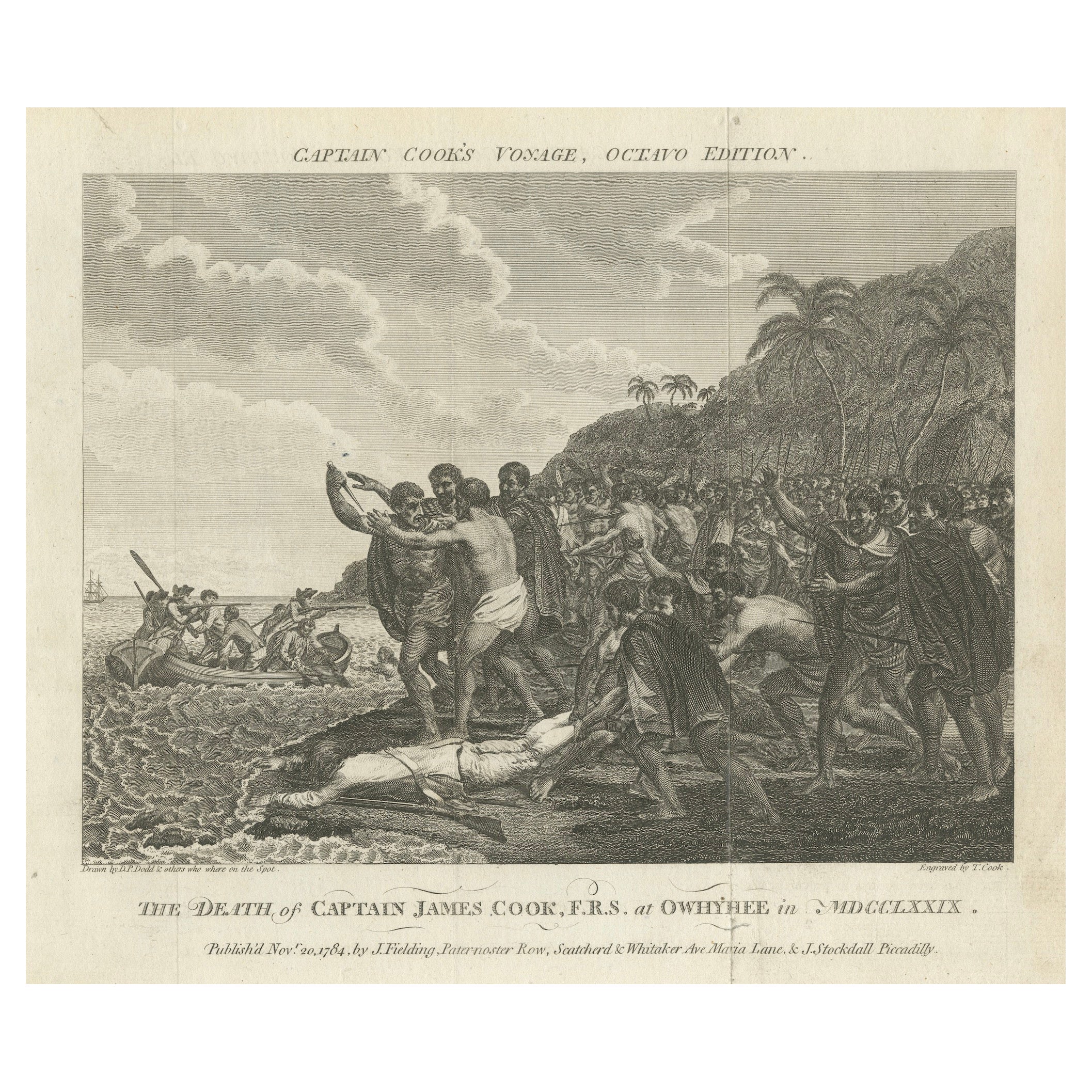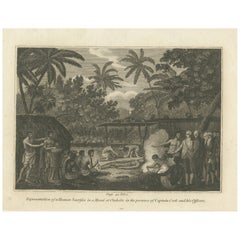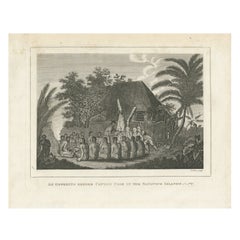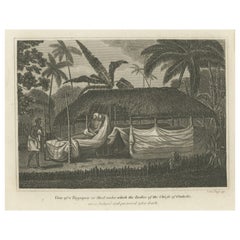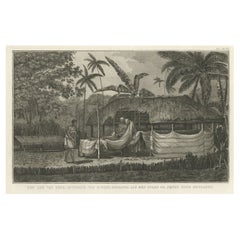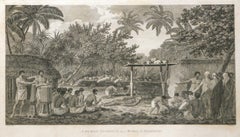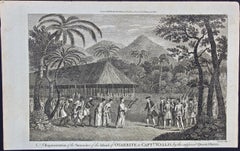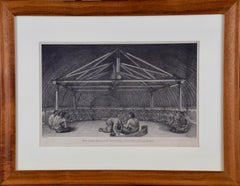Items Similar to Human Sacrifice in a Morai, Tahiti – Cook Voyage Engraving c.1795
Video Loading
Want more images or videos?
Request additional images or videos from the seller
1 of 11
Human Sacrifice in a Morai, Tahiti – Cook Voyage Engraving c.1795
$689.79
$862.2420% Off
£520.23
£650.2920% Off
€592
€74020% Off
CA$953.70
CA$1,192.1220% Off
A$1,068.30
A$1,335.3820% Off
CHF 561.11
CHF 701.3920% Off
MX$12,990.24
MX$16,237.8020% Off
NOK 7,105.51
NOK 8,881.8920% Off
SEK 6,745.04
SEK 8,431.3020% Off
DKK 4,506.69
DKK 5,633.3620% Off
About the Item
Menschelijke Offerhande in eene Morai of Otahiti verrigt – Human Sacrifice in Tahiti c.1795
This antique print depicts a dramatic and solemn scene of a human sacrifice performed in a Morai (temple enclosure) in Otaheite, now known as Tahiti. The engraving shows a group of islanders gathered around the ritual site, surrounded by dense tropical vegetation and tall palms. On the left, priests and attendants prepare the victim, while other figures sit or stand solemnly, observing the ritual. In the centre foreground, the sacrifice takes place near a stone platform with sacred offerings laid before idols and carved wooden structures. Smoke rises from a ceremonial fire, adding atmosphere to this powerful and rare depiction of Polynesian religious practices before European contact altered local traditions.
This engraving originates from ‘Reizen Rondom de Waereld door James Cook,’ the Dutch translation of James Cook’s voyages published circa 1795 by Honkoop, Allart en Van Cleef. The translation was prepared by J.D. Pasteur. Cook’s voyages brought detailed descriptions of Tahitian society to European audiences, revealing complex religious rituals and social structures. Prints like this, though interpreted through European eyes and engravers, remain significant records of early encounters and perceptions of Polynesian culture.
The technique used is engraving, a meticulous process where the image was incised onto a metal plate, inked, and pressed onto paper to produce a highly detailed and durable impression. Such engravings served as visual reportage for European readers eager to learn about distant lands and customs.
Condition summary: Very good condition with clean paper and strong impressions. Slight age-toning and minimal foxing near the margins but no tears or repairs. Paper remains firm and crisp.
Framing tips: A warm cream or light stone mount will complement the sepia-grey tones of the engraving. For framing, consider dark oak, mahogany, or black wood with a thin silver or gold inner edge for a classic museum-quality presentation. UV-protective glass is recommended to preserve the engraving’s detail over time.
- Dimensions:Height: 11.82 in (30 cm)Width: 20.67 in (52.5 cm)Depth: 0 in (0.02 mm)
- Materials and Techniques:Paper,Engraved
- Place of Origin:
- Period:
- Date of Manufacture:1803
- Condition:Condition summary: Very good condition with clean paper and strong impressions. Slight age-toning and minimal foxing near the margins but no tears or repairs. Paper remains firm and crisp.
- Seller Location:Langweer, NL
- Reference Number:Seller: BG-11487-72 1stDibs: LU3054326829392
About the Seller
5.0
Recognized Seller
These prestigious sellers are industry leaders and represent the highest echelon for item quality and design.
Platinum Seller
Premium sellers with a 4.7+ rating and 24-hour response times
Established in 2009
1stDibs seller since 2017
2,517 sales on 1stDibs
Typical response time: <1 hour
- ShippingRetrieving quote...Shipping from: Langweer, Netherlands
- Return Policy
Authenticity Guarantee
In the unlikely event there’s an issue with an item’s authenticity, contact us within 1 year for a full refund. DetailsMoney-Back Guarantee
If your item is not as described, is damaged in transit, or does not arrive, contact us within 7 days for a full refund. Details24-Hour Cancellation
You have a 24-hour grace period in which to reconsider your purchase, with no questions asked.Vetted Professional Sellers
Our world-class sellers must adhere to strict standards for service and quality, maintaining the integrity of our listings.Price-Match Guarantee
If you find that a seller listed the same item for a lower price elsewhere, we’ll match it.Trusted Global Delivery
Our best-in-class carrier network provides specialized shipping options worldwide, including custom delivery.More From This Seller
View AllCeremonial Rites: A Human Sacrifice in Otaheite (Tahiti), 1801
Located in Langweer, NL
The title for the provided engraving could be "Ceremonial Rites: A Human Sacrifice in Otaheite," capturing the gravity of the depicted event. This print likely illustrates a solemn a...
Category
Antique Early 1800s Prints
Materials
Paper
The Ceremonial Offering to Captain Cook in Hawaii, Engraved in 1778
Located in Langweer, NL
Title: "The Ceremonial Offering to Captain Cook in Hawaii, 1778"
This detailed antique engraving, titled "An Offering Before Captain Cook in the Sandwich Islands," captures a significant historical encounter from Captain James Cook's voyages. The artwork, based on a drawing by John Webber, who accompanied Cook, was skillfully translated into print by the combined talents of Samuel Middiman for the landscape and John Hall for the figures. Created around 1778, this scene illustrates a moment where indigenous Hawaiian men present offerings of suckling pigs to Captain Cook and his European companions. A towering figure wearing an imposing mask stands sentinel behind the Europeans, symbolizing the cultural richness and ceremonial traditions of the Hawaiian people. The scene is framed by native palms and lush tropical vegetation, with a typical steep-roofed thatched building enclosed by a fence in the background, hinting at the architectural styles of the era. This print, marked by 'Walker sculp', offers a poignant visual narrative of cultural exchange in the age of exploration.
Category
Antique Late 18th Century Prints
Materials
Paper
$456 Sale Price
20% Off
Free Shipping
Mourning the Chief: Engraving of The Morai at Otaheite, now called Tahiti, 1817
Located in Langweer, NL
An original historical engraving from G. Alexander Cooke's "Geography," published in 1817. The engraving is titled "View of a Tuppapon or Shed under which the Bodies of the Chiefs of...
Category
Antique 1810s Prints
Materials
Paper
$456 Sale Price
20% Off
Free Shipping
Antique Engraving of the Dead Chief of Tahiti Island in the Pacific, 1803
By James Cook
Located in Langweer, NL
Antique print titled 'Het Lijk van Thee, Opperste van O-Tahiti, zoodanig als men zulks na zijnen dood bewaarde'. Antique print depicting the remnents of Thee, Chief of Tahiti. Origin...
Category
Antique 19th Century Prints
Materials
Paper
$270 Sale Price
20% Off
Engraving of The Death of Captain James Cook at Kealakekua Bay, Hawaii, 1784
Located in Langweer, NL
A historical copper engraving depicting "The Death of Captain James Cook, F.R.S. at Owhyhee in MDCCLXXIX" (1779). This engraving is particularly sig...
Category
Antique Late 18th Century Prints
Materials
Paper
$391 Sale Price
20% Off
Free Shipping
Ceremonial Tribute to Captain Cook in the Hawaiian Archipelago, circa 1790
Located in Langweer, NL
Title: "Ceremonial Tribute to Captain Cook in the Hawaiian Archipelago"
Description: This antique print depicts a scene titled "An Offering before Capt'n Cook in the Sandwich Island...
Category
Antique Late 18th Century Prints
Materials
Paper
$55 Sale Price
20% Off
You May Also Like
A Human Sacrifice, in a Morai, in Otaheite (Tahiti) 1784 James Cook Final Voyage
By John Webber
Located in Paonia, CO
A Human Sacrifice in a Morai in Otaheite (Tahiti) 1784 by John Webber is from the First Edition Atlas Accompanying Capt. James Cook and King; Third and Final Voyage of Captain...
Category
1780s Realist Figurative Prints
Materials
Engraving
Surrender of Tahiti to Captain Wallis: An Original 18th C. Engraving
By John Webber
Located in Alamo, CA
"A Representation of the Surrender of the Island of Otaheite to Capt.n Wallis, by the Supposed Queen of Oberea" is an original 18th century engraving created by Sparrow, from a drawi...
Category
1780s Landscape Prints
Materials
Engraving
"King of the Friendly Islands" (Tonga); Engraving from Captain Cook's 3rd Voyage
By John Webber
Located in Alamo, CA
"Poulaho, King of the Friendly Islands, Drinking Kava" is an engraving created by William Sharp (1749-1824), from a drawing by John Webber (1752-1793), who was the artist on Captain James Cook's 3rd and final voyage of discovery. It was published in the atlas of "A Voyage to the Pacific Ocean Undertaken by the Command of His Majesty, for Making Discoveries in the Northern Hemisphere", the official British Admirality sanctioned journal published upon completion of the voyage in London in 1784 by Strahan & Cadell.
Captain Cook visited Tonga on his 3rd voyage, which he named The Friendly Islands because of the warm welcome he and his crew received, unlike some of the other more hostile Pacific islands. The engraving depicts Cook and his men observed a kava ceremony at the village of Mu’a on Tongatapu. King Paulaho sits in the centre foreground, his back to the spectator with a man kneeling before him. The ceremonial mat depicted behind Paulaho indicates that nobody was allowed to sit behind him. The figure in the centre holds a single cup, referring to the Tongan custom of offering the cup to the king first. Kava is native to the islands of the South Pacific and was first described for English readers in 1768 by Captain James Cook. The kava root has been used for centuries as a central feature of ceremonies and celebrations because it was able to bring about a calming and pleasant social atmosphere. The root was crushed and processed into coconut milk to become the focal ceremonial beverage, simply referred to as kava.
This engraving is presented in a Koa wood frame and a white mat. Koa wood is legendary in Hawaii. There are occasional faint spots, but the print is otherwise in very good condition. This amazing Koa wood is native to Hawaii and it is known for the deep rich colors and varied grain pattern. Koa has an honored heritage in Hawaii and is highly revered and sacred. The word “koa” means “warrior” in Hawaiian. The warriors of King Kamehameha the Great, created canoes and weapons from a wood plentiful on the Big Island of Hawaii. This wood became synonymous with the warriors themselves, and it became known as koa.
There are three other engravings listed from the official journal of Captain Cook's 3rd voyage available that are presented in identical Koa wood frames and mats (LU117324682422, LU117324684052, LU117324684032). They would make a wonderful grouping for a display of 2, 3 or 4 prints. A discount is available for a grouping depending on the number of items included.
Captain Cook is remembered as one of the greatest explorers and navigators in history. His explorations included Australia, New Zealand and islands of the South Pacific and the northwest coast of North America. Hawaii was discovered by Captain Cook during this voyage. Hawaii was originally called The Sandwich Islands in honor of The Earl of Sandwich...
Category
1780s Realist Figurative Prints
Materials
Engraving
Reception for Captain Cook, Tonga: Original 18th C. Engraving, Cook's 3rd Voyage
By John Webber
Located in Alamo, CA
"The Reception of Capt. Cook in Hapaee" is an original 18th century engraving from a drawing by John Webber (1751-1793), who was the artist who accompanied Captain Cook on his third ...
Category
1780s Landscape Prints
Materials
Engraving
"A Dance in Otaheite" (Tahiti), Engraving from Captain Cook's 3rd Voyage
By John Webber
Located in Alamo, CA
"A Dance in Otaheite" (Tahiti) is an engraving created by William Sharp (1749-1824), from a drawing by John Webber (1752-1793), who was the artist on Captain James Cook's 3rd and final voyage of discovery. It is a plate in the atlas of "A Voyage to the Pacific Ocean Undertaken by the Command of His Majesty, for Making Discoveries in the Northern Hemisphere", the official British Admirality sanctioned journal published upon completion of the voyage in London in 1784 by Strahan & Cadell.
Two women and two men wearing ceremonial costumes, performing a dance outdoors standing on a mat. Three men are playing the drums in the background, in front of a thatched roof building. An audience of men are sitting on both sides of the stage. By the time Webber arrived in Tahiti, 'south sea' imagery had become familiar. Webber gave concentrated attention to dance. He had the opportunity to distinguish the Tahitian dance from the more formalized dancing of Tonga. Whereas they seem to have called to mind the more formal dances of antiquity, the Tahitian dancing aroused memories of peasant and folk dancing.
This engraving is professionally framed in Koa wood. Koa wood is legendary in Hawaii. Not only is this amazing wood native to Hawaii, but it is known for the deep rich colors and varied grain pattern. Koa has an honored heritage in Hawaii and is highly revered and sacred. The word “koa” means “warrior” in Hawaiian. The warriors of King Kamehameha the Great, created canoes and weapons from a wood plentiful on the Big Island of Hawaii. This wood became synonymous with the warriors themselves, and it became known as koa.
The print is in excellent condition.
There are three other engravings listed from the official journal of Captain Cook's 3rd voyage available that are presented in identical Koa wood frames and double mats (LU117324682432, LU117324684052, LU117324684062). They would make a wonderful grouping for a display of 2, 3 or 4 prints. A discount is available for a grouping depending on the number of items included.
Hawaii was discovered by Captain Cook during this voyage. Hawaii was originally called The Sandwich Islands in honor of The Earl of Sandwich...
Category
1780s Realist Landscape Prints
Materials
Engraving
Original Antique Ethnographical Print, Figures, New South Wales, Australia, 1809
Located in St Annes, Lancashire
Wonderful ethnographical print.
A copper-plate engraving after Lesieur
Published by Sherwood, Neely & Jones. Dated 1809
Unframed.
Category
Antique Early 1800s English Folk Art Prints
Materials
Paper
More Ways To Browse
Curtis Jere Chrome Sculpture
Dalmatian Dog
Danish Dog
Diamond Inlay Chest
Dollar Pattern
Drop Front Walnut Secretary
Eileen Gray Lacquer
Francois Gerard
French Bulldog Art
French Primitive Cabinet
French Rococo Bed
Furniture Polish For Birdseye Maple
Georgian Chest On Stand
Green Giraffe
Hand Painted Bed Queen
Hexagon Game Table
Naked Figurine
Octopus Sculptures
